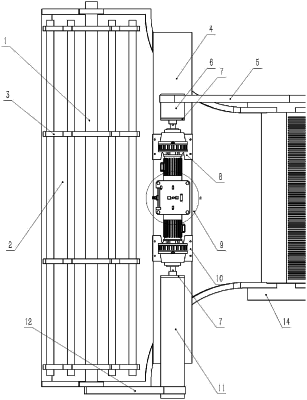| CPC A01D 41/1274 (2013.01) [G01S 17/88 (2013.01); G05B 11/42 (2013.01)] | 8 Claims |

|
1. An adaptive device for a header capable of performing lodging detection based on a laser sensor, comprising a transmission assembly and a laser sensor control assembly, wherein,
the transmission assembly comprises a rotating shaft of a roller, a harvesting part, a motor base plate, a transmission belt of the harvesting part, a transmission shaft of a first high-power motor, motor arms, the first high-power motor, a second high-power motor a transmission shaft of the second high-power motor, a transmission belt of the roller, and a rotating shaft of the harvesting part, wherein,
the motor base plate is fixed to an upper end of the harvesting part;
the first high-power motor and the second high-power motor are symmetrically fixed to the motor base plate via positioning holes;
the first high-power motor is connected to the transmission shaft of the first high-power motor via a positioning hole in the corresponding motor arm, and the transmission shaft of the first high-power motor transmits torque to the rotating shaft of the harvesting part through the transmission belt of the harvesting part for transmission; and
the second high-power motor is connected to the transmission shaft of the second high-power motor via a positioning hole in the corresponding motor arm, and the transmission shaft of the second high-power motor transmits torque to the rotating shaft of the roller through the transmission belt of the roller for transmission; and
the laser sensor control assembly comprises the motor base plate, upright lifting columns, a control base plate, a battery, a power distribution board, a voltage reduction module, electronic speed controllers, a main control board, a low-power motor, a laser sensor base plate, a laser sensor, tube clamps, a rotating shaft of the laser sensor, and a bearing for stabilizing the rotating shaft of the laser sensor, wherein,
the control base plate is arranged above the motor base plate through the upright lifting columns;
the battery, the power distribution board, the voltage reduction module, the main control board, and three electronic speed controllers are all bonded to the control base plate with double-sided adhesives; the low-power motor is fixed to the control base plate through an L-shaped support and close to a front end of the control base plate;
one end of the rotating shaft of the laser sensor is connected to the low-power motor through the motor arm, and the other end of the rotating shaft of the laser sensor is fixed by the bearing for stabilizing the rotating shaft of the laser sensor; and
the laser sensor is fixed at a center of the rotating shaft of the laser sensor through the laser sensor base plate by the tube clamps.
|
|
5. A control method of an adaptive device for a header capable of performing lodging detection based on a laser sensor, comprising the following steps:
step 1, turning on a main switch of a power supply to make a low-power motor and a main control board be respectively powered on, wherein a first high-power motor and a second high-power motor are powered on through an internal diesel generator;
step 2, when a combine harvester moves forwards, controlling, by the main control board, the first high-power motor to adjust a harvesting part to be horizontal, and presetting, through the main control board, a basic rotation speed for the second high-power motor;
step 3, performing data preprocessing on a laser sensor through the following steps: firstly, extracting, based on a region of interest (ROI), data only retained within a threshold range of a preset region in front of the combine harvester; and secondly, filtering outliers in the data by a statistical filter;
step 4, presetting a basic rotation speed for the low-power motor such that the low-power motor drives the laser sensor to repeatedly scan up and down within a constant angle; and receiving and storing, by a microprocessor, point cloud data of the laser sensor, and displaying, by the microprocessor, the point cloud data within a complete scanning cycle on a serial screen; and
step 5, the microprocessor analyzes and processes the laser point cloud data of N frames, and adjusts an output according to a proportion integration differentiation (PID) to select different harvesting modes.
|